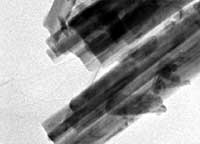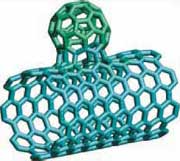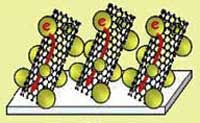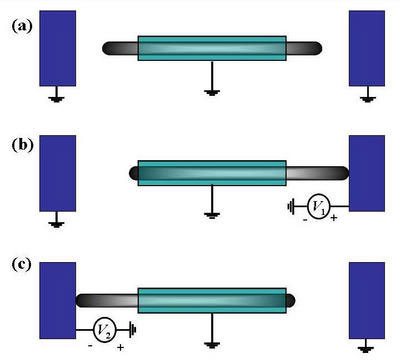Showing Spotlights 265 - 272 of 318 in category All (newest first):
 Carbon nanotubes (CNTs) have captured the imagination of many scientists and engineers as a result of properties of individual tubes (e.g. very high electrical and thermal conductivities, high stiffness). Things often get 'messy' however, when one tries to make them work collectively, e.g. in composites. Three-dimensional networks of carbon nanotubes are usually made within a supporting material, such as in polymer composite or liquid dispersion. While networks of CNTs have been observed transiently in furnaces with lots of raw nanotube material, such an approach does not permit much experimental control over the resulting network. A novel approach to fabricating CNT networks are CNT aerogels. Aerogels are novel materials in their own right - a material derived from gel in which the liquid component of the gel has been replaced with gas. The result is an extremely low density solid. Microscopically, aerogels are composed of tenuous networks of clustered nanoparticles. These materials often have unique properties due to their very high strength-to-weight and surface-area-to-volume ratios. To date, most aerogels are fabricated from silica or pyrolized organic polymers. Fabricating aerogels with CNTs offers potential for improvement over current carbon aerogel technologies in device applications such as sensors, actuators, electrodes, and thermoelectrics.
Carbon nanotubes (CNTs) have captured the imagination of many scientists and engineers as a result of properties of individual tubes (e.g. very high electrical and thermal conductivities, high stiffness). Things often get 'messy' however, when one tries to make them work collectively, e.g. in composites. Three-dimensional networks of carbon nanotubes are usually made within a supporting material, such as in polymer composite or liquid dispersion. While networks of CNTs have been observed transiently in furnaces with lots of raw nanotube material, such an approach does not permit much experimental control over the resulting network. A novel approach to fabricating CNT networks are CNT aerogels. Aerogels are novel materials in their own right - a material derived from gel in which the liquid component of the gel has been replaced with gas. The result is an extremely low density solid. Microscopically, aerogels are composed of tenuous networks of clustered nanoparticles. These materials often have unique properties due to their very high strength-to-weight and surface-area-to-volume ratios. To date, most aerogels are fabricated from silica or pyrolized organic polymers. Fabricating aerogels with CNTs offers potential for improvement over current carbon aerogel technologies in device applications such as sensors, actuators, electrodes, and thermoelectrics.
Mar 15th, 2007
 It seems that with every new study on the toxicity of nanomaterials there remain more questions afterwards than before. Environmental, occupational and public exposure to engineered nanoparticles will increase dramatically in the near future as a result of the widespread use of nanoparticles for consumer and industrial products. The extent of future exposure to nanoparticles associated with these new products is still unknown. So far only limited data is available regarding carbon nanotube (CNT) toxicity. As a result still not much is known about their impact on biological systems including humans. Discussions regarding the potential risks of their widespread use, as well as their possible positive impact are just beginning to take place. In order to provide a basis for comparison to existing epidemiological data, a group of researchers in Switzerland and Germany have investigated CNTs at various degrees of agglomeration using an in vitro cytotoxicity study with human cancer cells. The cytotoxic effects of well-dispersed CNT were compared with that of conventionally purified rope-like agglomerated CNTs and asbestos as a reference. While suspended CNT-bundles were less cytotoxic than asbestos, rope-like agglomerates induced more pronounced cytotoxic effects than asbestos fibers at the same concentrations. The study underlines the need for thorough materials characterization prior to toxicological studies and corroborates the role of agglomeration in the cytotoxic effect of nanomaterials.
It seems that with every new study on the toxicity of nanomaterials there remain more questions afterwards than before. Environmental, occupational and public exposure to engineered nanoparticles will increase dramatically in the near future as a result of the widespread use of nanoparticles for consumer and industrial products. The extent of future exposure to nanoparticles associated with these new products is still unknown. So far only limited data is available regarding carbon nanotube (CNT) toxicity. As a result still not much is known about their impact on biological systems including humans. Discussions regarding the potential risks of their widespread use, as well as their possible positive impact are just beginning to take place. In order to provide a basis for comparison to existing epidemiological data, a group of researchers in Switzerland and Germany have investigated CNTs at various degrees of agglomeration using an in vitro cytotoxicity study with human cancer cells. The cytotoxic effects of well-dispersed CNT were compared with that of conventionally purified rope-like agglomerated CNTs and asbestos as a reference. While suspended CNT-bundles were less cytotoxic than asbestos, rope-like agglomerates induced more pronounced cytotoxic effects than asbestos fibers at the same concentrations. The study underlines the need for thorough materials characterization prior to toxicological studies and corroborates the role of agglomeration in the cytotoxic effect of nanomaterials.
Mar 12th, 2007
 Since their discovery in the early 1990s, carbon nanotubes (CNTs) and carbon nanofibers (CNFs) have been used in a wide variety of applications. They have become indispensable in nanosciences and nanotechnology. However, because their production on an industrial scale remains expensive, their commercial use in such areas as catalysis has remained unthinkable. Current production processes including preparation of the support, normally silica or alumina, and impregnation with catalytically active metal for hydrocarbon decomposition, are not suitable for mass production. Researchers in Germany now report the fabrication of carbon nanotubes and carbon nanofibers on Mount Etna lavas used both as support and as catalyst, the first step for industrial production without preparation of support and its wet-chemical treatment. Such fabrication of CNTs/CNFs on naturally occurring minerals without synthetically prepared catalyst could pave the way for further exploitation of the superior properties of tailored nanostructured carbon for large-scale applications, such as catalysis and water purification by adsorption.
Since their discovery in the early 1990s, carbon nanotubes (CNTs) and carbon nanofibers (CNFs) have been used in a wide variety of applications. They have become indispensable in nanosciences and nanotechnology. However, because their production on an industrial scale remains expensive, their commercial use in such areas as catalysis has remained unthinkable. Current production processes including preparation of the support, normally silica or alumina, and impregnation with catalytically active metal for hydrocarbon decomposition, are not suitable for mass production. Researchers in Germany now report the fabrication of carbon nanotubes and carbon nanofibers on Mount Etna lavas used both as support and as catalyst, the first step for industrial production without preparation of support and its wet-chemical treatment. Such fabrication of CNTs/CNFs on naturally occurring minerals without synthetically prepared catalyst could pave the way for further exploitation of the superior properties of tailored nanostructured carbon for large-scale applications, such as catalysis and water purification by adsorption.
Mar 9th, 2007
 Carbon comes in many different forms, from the graphite found in pencils to the world's most expensive diamonds. While diamonds might be very popular among ladies, the two most celebrated carbon materials among nanotechnology scientists are fullerenes and carbon nanotubes. What makes them so interesting are the many advantageous properties that they exhibit. Despite the similarities between these two forms of carbon, there have been very few attempts to physically merge them. An international research group, led by a Finnish team, now has discovered a novel hybrid material that combines fullerenes and single-walled carbon nanotubes (SWCNTs) into a single structure in which the fullerenes are covalently bonded to the outer surface of the SWCNTs. In this newly discovered material, that the researchers termed NanoBuds, the fullerene molecules are attached to the outside surface of the carbon nanotubes, just like buds on the branch of a tree - hence the name - and can be made in a simple one-step process. These NanoBuds have been shown to be extremely efficient electron emitters and have excellent electrical conductive properties. In fact, as NanoBuds combine the chemical reactivity of fullerenes and electrical, optical as well as mechanical properties of carbon nanotubes, they may one day replace current materials in many products. Research is continuing to explore NanoBuds' properties with a view to using them in a wide range of applications.
Carbon comes in many different forms, from the graphite found in pencils to the world's most expensive diamonds. While diamonds might be very popular among ladies, the two most celebrated carbon materials among nanotechnology scientists are fullerenes and carbon nanotubes. What makes them so interesting are the many advantageous properties that they exhibit. Despite the similarities between these two forms of carbon, there have been very few attempts to physically merge them. An international research group, led by a Finnish team, now has discovered a novel hybrid material that combines fullerenes and single-walled carbon nanotubes (SWCNTs) into a single structure in which the fullerenes are covalently bonded to the outer surface of the SWCNTs. In this newly discovered material, that the researchers termed NanoBuds, the fullerene molecules are attached to the outside surface of the carbon nanotubes, just like buds on the branch of a tree - hence the name - and can be made in a simple one-step process. These NanoBuds have been shown to be extremely efficient electron emitters and have excellent electrical conductive properties. In fact, as NanoBuds combine the chemical reactivity of fullerenes and electrical, optical as well as mechanical properties of carbon nanotubes, they may one day replace current materials in many products. Research is continuing to explore NanoBuds' properties with a view to using them in a wide range of applications.
Mar 5th, 2007
 The photocatalytic activity of nanostructured semiconductor films has been widely explored in designing solar cells, solar hydrogen production, and environmental remediation. Of particular interest is the dye-sensitized solar cell (DSSC) which uses nanostructured titanium dioxide films modified with sensitizing dyes. Despite the initial success of achieving 10% solar conversion efficiency, the effort to further improve their performance has not been very successful. A major hurdle in attaining higher photoconversion efficiency in such nanostructured electrodes is the transport of electrons across the particle network. The photogenerated electrons in nanostructured films for example have to travel through the network of semiconductor particles and encounter many grain boundaries during the transit. Such a random transit path for the photogenerated electrons increases the probability of their recombination with oxidized sensitizer. With the recent advance in the design of nanotube and nanowire architecture, it should be possible to use such one-dimensional nanostructures to direct the flow of photogenerated charge carriers. The obvious challenge is to use nanowire or nanotube networks as support to anchor light-harvesting semiconductor particles and facilitate the electron transport to the collecting electrode surface in a solar cell. Researchers now have demonstrated that single wall carbon nanotube (SWCNT) architecture when employed as conducting scaffolds in a titanium dioxide semiconductor based photoelectrochemical cell can boost the photoconversion efficiency by a factor of 2.
The photocatalytic activity of nanostructured semiconductor films has been widely explored in designing solar cells, solar hydrogen production, and environmental remediation. Of particular interest is the dye-sensitized solar cell (DSSC) which uses nanostructured titanium dioxide films modified with sensitizing dyes. Despite the initial success of achieving 10% solar conversion efficiency, the effort to further improve their performance has not been very successful. A major hurdle in attaining higher photoconversion efficiency in such nanostructured electrodes is the transport of electrons across the particle network. The photogenerated electrons in nanostructured films for example have to travel through the network of semiconductor particles and encounter many grain boundaries during the transit. Such a random transit path for the photogenerated electrons increases the probability of their recombination with oxidized sensitizer. With the recent advance in the design of nanotube and nanowire architecture, it should be possible to use such one-dimensional nanostructures to direct the flow of photogenerated charge carriers. The obvious challenge is to use nanowire or nanotube networks as support to anchor light-harvesting semiconductor particles and facilitate the electron transport to the collecting electrode surface in a solar cell. Researchers now have demonstrated that single wall carbon nanotube (SWCNT) architecture when employed as conducting scaffolds in a titanium dioxide semiconductor based photoelectrochemical cell can boost the photoconversion efficiency by a factor of 2.
Feb 28th, 2007
 With an increased focus on alternative sources of cheap, abundant, clean energy, solar cells are receiving lots of attention. Harnessing the power of the sun to replace the use of fossil fuels holds tremendous promise. One way to do this is through the use of solar, or photovoltaic, cells. Until now, solar cells that convert sunlight to electric power have been dominated by solid state junction devices, often made of silicon wafers. Thanks to nanotechnology, this is now being challenged by the development of a new generation of solar cells based on thin film materials, nanocrystalline materials and conducting polymeric films. These offer the prospects of cheaper materials, higher efficiency and flexible features. This has opened up new opportunities in solar cell research and development and, consequently, there is considerable investor interest in solar nanotechnology startups. Both inventors and investors are betting that flexible sheets of solar cells used to harness the sun's strength will ultimately provide a cheap and efficient source of energy.
With an increased focus on alternative sources of cheap, abundant, clean energy, solar cells are receiving lots of attention. Harnessing the power of the sun to replace the use of fossil fuels holds tremendous promise. One way to do this is through the use of solar, or photovoltaic, cells. Until now, solar cells that convert sunlight to electric power have been dominated by solid state junction devices, often made of silicon wafers. Thanks to nanotechnology, this is now being challenged by the development of a new generation of solar cells based on thin film materials, nanocrystalline materials and conducting polymeric films. These offer the prospects of cheaper materials, higher efficiency and flexible features. This has opened up new opportunities in solar cell research and development and, consequently, there is considerable investor interest in solar nanotechnology startups. Both inventors and investors are betting that flexible sheets of solar cells used to harness the sun's strength will ultimately provide a cheap and efficient source of energy.
Feb 22nd, 2007
 Non-volatile random access memory (NVRAM) is the general name used to describe any type of random access memory which does not lose its information when power is turned off. This is in contrast to the most common forms of random access memory today, DRAM and SRAM, which both require continual power in order to maintain their data. NVRAM is a subgroup of the more general class of non-volatile memory types, the difference being that NVRAM devices offer random access, as opposed to sequential access like hard disks. The best-known form of NVRAM memory today is flash memory, which is found in a wide variety of consumer electronics, including memory cards, digital music players, digital cameras and cell phones. One problem with flash memory is its relatively low speed. Also, as chip designers and engineers reach size barriers in downscaling the size of such chips, the research focus shifts towards new types of nanomemory. Molecular-scale memory promises to be low-power and high frequency: imagine a computer that boots up immediately on powering up and that writes data directly onto its hard drive making saving a thing of the past. Researchers are designing the building blocks for this type of memory device using telescoping carbon nanotubes as high-speed, low power microswitches. The design would allow the use of these binary or three-stage switches to become part of molecular-scale computers.
Non-volatile random access memory (NVRAM) is the general name used to describe any type of random access memory which does not lose its information when power is turned off. This is in contrast to the most common forms of random access memory today, DRAM and SRAM, which both require continual power in order to maintain their data. NVRAM is a subgroup of the more general class of non-volatile memory types, the difference being that NVRAM devices offer random access, as opposed to sequential access like hard disks. The best-known form of NVRAM memory today is flash memory, which is found in a wide variety of consumer electronics, including memory cards, digital music players, digital cameras and cell phones. One problem with flash memory is its relatively low speed. Also, as chip designers and engineers reach size barriers in downscaling the size of such chips, the research focus shifts towards new types of nanomemory. Molecular-scale memory promises to be low-power and high frequency: imagine a computer that boots up immediately on powering up and that writes data directly onto its hard drive making saving a thing of the past. Researchers are designing the building blocks for this type of memory device using telescoping carbon nanotubes as high-speed, low power microswitches. The design would allow the use of these binary or three-stage switches to become part of molecular-scale computers.
Feb 14th, 2007
 For several years now, researchers have documented the many intriguing mechanical and electrical properties of carbon nanotubes (CNTs). Some researchers have focused on the optical properties of CNTs. Studying the passive optical response of CNTs they have revealed the manner in which CNTs' optical properties are related to shape and structure of CNTs. It was found that periodic CNT arrays exhibit Bragg diffraction, photonic bandgap properties, and plasmonic resonance; nonperiodic CNT arrays interact with light waves similarly to the way in which radio antennae interact with radio waves. In conventional radio antenna theory an antenna acts as a resonator of the external electromagnetic radiation. Scientists now have demonstrated that a single multiwall carbon nanotube (MWCNT) acts as an optical antenna, whose response is fully consistent with conventional radio antenna theory.
For several years now, researchers have documented the many intriguing mechanical and electrical properties of carbon nanotubes (CNTs). Some researchers have focused on the optical properties of CNTs. Studying the passive optical response of CNTs they have revealed the manner in which CNTs' optical properties are related to shape and structure of CNTs. It was found that periodic CNT arrays exhibit Bragg diffraction, photonic bandgap properties, and plasmonic resonance; nonperiodic CNT arrays interact with light waves similarly to the way in which radio antennae interact with radio waves. In conventional radio antenna theory an antenna acts as a resonator of the external electromagnetic radiation. Scientists now have demonstrated that a single multiwall carbon nanotube (MWCNT) acts as an optical antenna, whose response is fully consistent with conventional radio antenna theory.
Feb 13th, 2007
 Carbon nanotubes (CNTs) have captured the imagination of many scientists and engineers as a result of properties of individual tubes (e.g. very high electrical and thermal conductivities, high stiffness). Things often get 'messy' however, when one tries to make them work collectively, e.g. in composites. Three-dimensional networks of carbon nanotubes are usually made within a supporting material, such as in polymer composite or liquid dispersion. While networks of CNTs have been observed transiently in furnaces with lots of raw nanotube material, such an approach does not permit much experimental control over the resulting network. A novel approach to fabricating CNT networks are CNT aerogels. Aerogels are novel materials in their own right - a material derived from gel in which the liquid component of the gel has been replaced with gas. The result is an extremely low density solid. Microscopically, aerogels are composed of tenuous networks of clustered nanoparticles. These materials often have unique properties due to their very high strength-to-weight and surface-area-to-volume ratios. To date, most aerogels are fabricated from silica or pyrolized organic polymers. Fabricating aerogels with CNTs offers potential for improvement over current carbon aerogel technologies in device applications such as sensors, actuators, electrodes, and thermoelectrics.
Carbon nanotubes (CNTs) have captured the imagination of many scientists and engineers as a result of properties of individual tubes (e.g. very high electrical and thermal conductivities, high stiffness). Things often get 'messy' however, when one tries to make them work collectively, e.g. in composites. Three-dimensional networks of carbon nanotubes are usually made within a supporting material, such as in polymer composite or liquid dispersion. While networks of CNTs have been observed transiently in furnaces with lots of raw nanotube material, such an approach does not permit much experimental control over the resulting network. A novel approach to fabricating CNT networks are CNT aerogels. Aerogels are novel materials in their own right - a material derived from gel in which the liquid component of the gel has been replaced with gas. The result is an extremely low density solid. Microscopically, aerogels are composed of tenuous networks of clustered nanoparticles. These materials often have unique properties due to their very high strength-to-weight and surface-area-to-volume ratios. To date, most aerogels are fabricated from silica or pyrolized organic polymers. Fabricating aerogels with CNTs offers potential for improvement over current carbon aerogel technologies in device applications such as sensors, actuators, electrodes, and thermoelectrics.
 Subscribe to our Nanotechnology Spotlight feed
Subscribe to our Nanotechnology Spotlight feed





